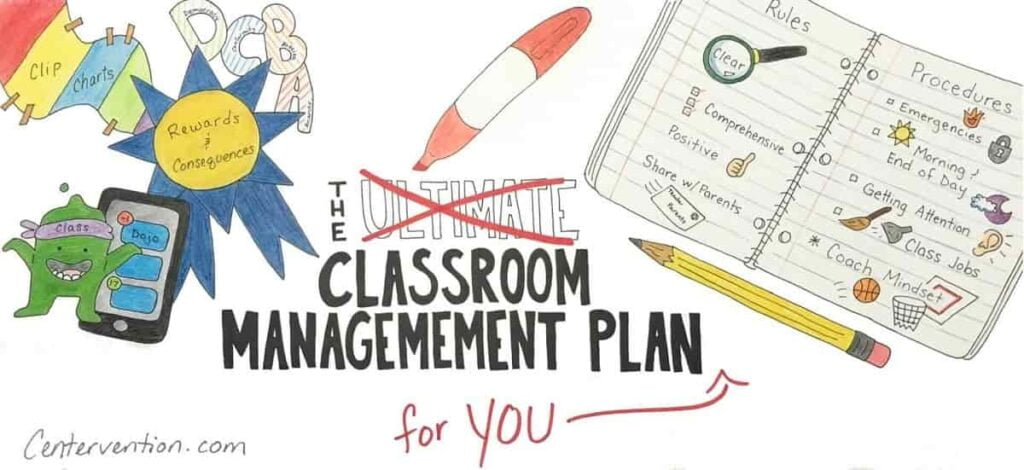In any classroom, whether it be a kindergarten or a college lecture hall, effective classroom management is crucial for creating an environment where students can thrive. A well-designed classroom management plan ensures that the learning environment is conducive to knowledge absorption and retention and fosters positive relationships between teachers and students. In this article, we will explore the three primary goals of a classroom management plan and discuss strategies for achieving them.
Understanding Classroom Management
Before delving into the three goals, it is essential to understand what classroom management entails. Classroom management refers to educators’ strategies and techniques to establish and maintain an orderly and productive learning environment. Effective classroom management helps to minimize disruptions, keep students engaged, and nurture a positive and inclusive classroom culture.
Classroom management is a multifaceted concept encompassing various teaching and learning aspects. It involves maintaining discipline and creating a conducive atmosphere for academic growth and personal development. A well-managed classroom is like a well-oiled machine where every student feels valued, respected, and motivated to learn.
One crucial aspect of classroom management is establishing clear expectations and boundaries. By clearly communicating the rules and guidelines, teachers provide students with a framework for behavior and academic performance. This clarity helps students understand what is expected of them and enables them to take ownership of their actions.
Another key component of effective classroom management is promoting student engagement. Engaged students are more likely to be active participants in their learning, leading to improved academic performance. Teachers can foster engagement by using a variety of instructional strategies, such as hands-on activities, group discussions, and interactive technology. Students actively involved in the learning process are more likely to retain information and develop critical thinking skills.
In addition to clear expectations and student engagement, creating a positive learning environment is vital for effective classroom management. A positive learning environment is characterized by mutual respect, support, and inclusivity. Teachers can foster such an environment by establishing rapport with their students, encouraging collaboration and teamwork, and celebrating diversity. When students feel safe and valued, they are more likely to take risks, ask questions, and actively participate in classroom activities.
The Importance of Classroom Management
Classroom management is more than just keeping students in line. It plays a significant role in shaping students’ attitudes towards learning, their peers, and themselves. By effectively managing a classroom, teachers set the stage for students to develop essential social and emotional skills, build self-confidence, and engage actively in their education. A well-managed classroom provides a safe and supportive space where students can thrive academically and personally.
When classroom management is implemented effectively, students feel a sense of belonging and ownership in their learning environment. They develop a positive mindset towards education, viewing it as a valuable and enjoyable experience. This positive attitude enhances their academic performance and prepares them for future challenges and opportunities.
Furthermore, classroom management helps create a sense of community within the classroom. When students feel connected to their peers and their teacher, they are more likely to collaborate, support one another, and celebrate each other’s successes. This sense of community fosters a positive and inclusive classroom culture, where diversity is celebrated, and differences are respected.
Key Components of Classroom Management
When designing a classroom management plan, it is essential to consider the key components that make it effective. These components include establishing clear expectations and boundaries, promoting student engagement, and creating a positive learning environment. Educators can create a classroom that fosters cooperation, growth, and success by focusing on these three goals.
Establishing clear expectations and boundaries involves setting behavioral and academic standards that are communicated to students from the beginning. By clearly outlining the rules and consequences, teachers provide students with a sense of structure and predictability. This clarity helps students understand what is expected of them and promotes a sense of responsibility and accountability.
Promoting student engagement involves creating a dynamic and interactive learning environment. Teachers can achieve this by incorporating a variety of instructional strategies, such as hands-on activities, group work, and technology integration. Engaged students are more likely to be motivated, focused, and actively involved in their learning, leading to improved academic outcomes.
Creating a positive learning environment involves fostering a sense of belonging, respect, and inclusivity. Teachers can achieve this by building positive relationships with their students, modeling empathy and understanding, and promoting a culture of acceptance and appreciation. When students feel safe, valued, and supported, they are more likely to take risks, express their ideas, and collaborate with their peers.
3 Goals for a Classroom Management Plan
Goal 1: Creating a Positive Learning Environment
A positive learning environment is the cornerstone of effective classroom management. When students feel safe, respected, and valued, they are more likely to participate in their education actively. This positive atmosphere fosters a sense of belonging and encourages students to take risks, ask questions, and engage in meaningful discussions.
To create a positive learning environment, teachers can implement various strategies:
- Building positive relationships with students through open communication and mutual respect. Teachers can take the time to get to know their students on a personal level, showing genuine interest in their lives and experiences. By establishing trust, teachers can create an environment where students feel comfortable expressing their thoughts and concerns.
- Praising and encouraging students’ efforts and achievements. Recognizing and celebrating students’ accomplishments, no matter how big or small, can boost their self-esteem and motivation. Teachers can provide specific feedback highlighting each student’s strengths and progress, fostering a growth mindset and a desire to continue learning.
- Creating a visually appealing and organized classroom space. The physical environment plays a significant role in shaping students’ attitudes and behaviors. Teachers can decorate their classrooms with colorful and engaging displays that reflect the diversity of their students’ backgrounds and interests. Maintaining an organized space with clear expectations and routines also helps students feel a sense of structure and stability.
- Providing opportunities for collaboration and teamwork. Collaborative learning experiences promote social interaction, critical thinking, and problem-solving skills. Teachers can incorporate group projects, discussions, and cooperative learning activities that encourage students to work together, share ideas, and learn from one another. This not only enhances their academic growth but also cultivates important interpersonal skills.
It is also crucial to measure the impact of a positive environment and make adjustments as necessary. Regularly assessing students’ well-being and engagement can help educators gauge their efforts’ effectiveness and identify improvement areas. This can be done through surveys, observations, and conversations with students. By actively seeking feedback and involving students in the process, teachers can continuously refine their practices and ensure that the learning environment remains supportive and conducive to growth.
In conclusion, creating a positive learning environment goes beyond simply managing behavior. It involves fostering a sense of community, building relationships, and providing opportunities for students to thrive academically and emotionally. By prioritizing the creation of a positive learning environment, teachers can lay the foundation for a successful and enriching educational experience for all students.
Goal 2: Promoting Student Engagement
Engaged students are more likely to retain information and develop a love for learning. As a result, promoting student engagement is a fundamental goal of any classroom management plan. Here are some techniques that teachers can use to encourage active participation:
- Designing lessons that are relevant and meaningful to students’ lives.
- Using a variety of instructional strategies, such as hands-on activities, group discussions, and multimedia presentations.
- Incorporating technology into the learning process.
- Providing regular opportunities for student choice and autonomy.
Engagement plays a vital role in student success, so it is crucial for educators to prioritize this goal in their classroom management plan.
Goal 3: Establishing Clear Expectations and Boundaries
Clear expectations and boundaries are essential for maintaining a well-managed classroom. When students understand what is expected of them and the consequences of their actions, they are more likely to make positive choices. To establish clear expectations and boundaries, teachers can utilize the following techniques:
- Communicating rules and guidelines clearly and consistently.
- Creating a sense of ownership by involving students in rule-setting.
- Providing clear and fair consequences for both positive and negative behavior.
- Modeling appropriate behavior and enforcing rules consistently.
Teachers create a structured and supportive learning environment that benefits all students by setting clear expectations and boundaries.
Implementing Your Classroom Management Plan
Once a classroom management plan has been developed, the next step is to implement it effectively. Introducing the plan to the classroom requires careful thought and preparation. Here are some steps to consider:
- Explain the purpose and benefits of the classroom management plan to students.
- Review and discuss the specific expectations and rules with the class.
- Model appropriate behavior and provide examples to clarify expectations.
- Allow for questions and discussion to ensure student understanding.
It is important to remember that implementing a classroom management plan is ongoing. Teachers should regularly evaluate its effectiveness and make necessary adjustments to meet the needs of their students better.
Monitoring and Adjusting Your Plan Over Time
Effective classroom management requires teachers to be flexible and adaptable. Monitoring and adjusting the classroom management plan over time is crucial for ensuring its continued success. By regularly assessing student behavior and engagement, teachers can identify areas for improvement and make necessary adjustments. This might include modifying rules, incorporating new strategies, or addressing specific challenges that arise in the classroom. By emphasizing continuous improvement, educators can create an environment that is always evolving and responsive to the needs of their students.
In conclusion, a well-designed classroom management plan is essential for creating an environment where students can thrive. By focusing on goals such as creating a positive learning environment, promoting student engagement, and establishing clear expectations and boundaries, educators can lay the foundation for a successful and fulfilling educational experience. Teachers can build a classroom that fosters growth, curiosity, and achievement through careful planning and ongoing evaluation.


![Best Teacher Evaluation Rubric for 2025 [Ultimate Guide]](https://educationwalkthrough.com/wp-content/uploads/2025/08/Best-Teacher-Evaluation-Rubric-for-2025-Ultimate-Guide-300x200.jpg)

